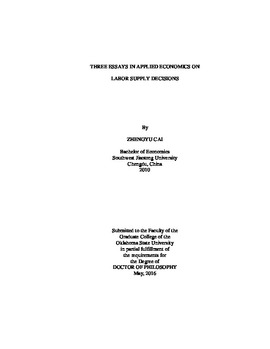| dc.contributor.advisor | Rickman, Dan S. | |
| dc.contributor.author | Cai, Zhengyu | |
| dc.date.accessioned | 2017-02-22T22:11:51Z | |
| dc.date.available | 2017-02-22T22:11:51Z | |
| dc.date.issued | 2016-05 | |
| dc.identifier.uri | https://hdl.handle.net/11244/48934 | |
| dc.description.abstract | The present study contains three applied economic essays which empirically investigate regional and educational factors influencing labor supply decisions. The first essay uses minimum distance from work PUMA centroid to the US coastlines and estimated industry share in 1930 as instrumental variables, and tests the causal impact of agglomeration on work intensity of the self-employed. The 2SLS results show that only localization has a positive impact on hours worked of the self-employed. Urbanization does not affect hours worked. The causality mostly comes from competition within industries. | |
| dc.description.abstract | The second essay uses 1% IPUMS ACS 2013 data to study self-employment differential between foreign STEM graduates and non-STEM graduates. The empirical results show that the differential is still quite substantial after controlling for several covariates. Furthermore, self-employment differentials across broad major groups and detailed majors are examined. We try to explain the self-employment differentials through the differences in incomes between self-employed and salaried foreign college graduates. Our empirical results show that foreign STEM graduates are less likely to be self-employed, since they could earn significantly more in salaried jobs, but the income advantage disappears when they shift to self-employment. This paper implies that, on one hand, policy makers could consider lowering the immigration barrier for graduates in non-STEM fields with high self-employment rates, or at least reduce the institutional discrimination between STEM and non-STEM graduates. On the other hand, target-based subsidies and/or tax benefits could be offered to the startups co-funded by foreign STEM graduates and those who are educated in fields with high self-employment rates. | |
| dc.description.abstract | The third essay uses instrumental variable estimation to examine two-way causality between human capital externalities and agglomeration. The empirical results show that human capital externality has much more causal impact on agglomeration than the reverse. The relationship between human capital externality and urbanization is much stronger than that with localization for both directions of causality. Then the relationship is used to analyze the causality between human capital spillover and hours worked. | |
| dc.format | application/pdf | |
| dc.language | en_US | |
| dc.rights | Copyright is held by the author who has granted the Oklahoma State University Library the non-exclusive right to share this material in its institutional repository. Contact Digital Library Services at lib-dls@okstate.edu or 405-744-9161 for the permission policy on the use, reproduction or distribution of this material. | |
| dc.title | Three essays in applied economics on labor supply decisions | |
| dc.contributor.committeeMember | Winters, John V. | |
| dc.contributor.committeeMember | Azam, Mehtabul | |
| dc.contributor.committeeMember | Comer, Jonathan Charles | |
| osu.filename | Cai_okstate_0664D_14502.pdf | |
| osu.accesstype | Open Access | |
| dc.type.genre | Dissertation | |
| dc.type.material | Text | |
| thesis.degree.discipline | Economics | |
| thesis.degree.grantor | Oklahoma State University | |
